Construction projects are complicated. Often involving hundreds of people, companies and opinions. To provide order on your project processes should be in place. One of the most important processes on a construction project is the RFI process. What is an RFI, and how can it be used effectively on a construction project?
The term RFI is an acronym for request for information. It is a formal process that is used to ask a question on a project.
While the basic definition is simple there are many complexities in the RFI process. Today we’re going to run through a number of areas including:
- When to issue to an RFI
- The process of issuing an RFI
- Responding to an RFI
- How to track and manage RFIs
- Trends to be aware of
- Best practices for issuing RFIs
When To Issue A Request For Information
When I first started this website one of the first articles I wrote was on how to issue an RFI. In that article I covered the ins and outs of issuing one. While that covered the details today we’re going to look at the process from a high level.
When a contractor comes across something that requires further detail they will issue an RFI to the consultant or owner.
I’ve summarized below a few examples to get you started:
- There are dimensions missing on the documents that you need to properly build the space.
- There is a material, wall type or detail missing from the drawings.
- Two drawings don’t line up with one another in the same set (ie architectural)
- Two drawings from different sets don’t align and cause an interference with one another
- A site condition that is not reflective of what’s on the drawings is uncovered on site.
- Documenting a directive provided on site from a consultant.
- The specification is either missing pieces or does not align with the drawings.
- A decision is required by a certain date by the owner or consultant.
These are just a few examples of when you can issue an RFI as a contractor. There are many different reasons. Generally speaking – if you need to record a decision on a jobsite an RFI is a great way of doing so.
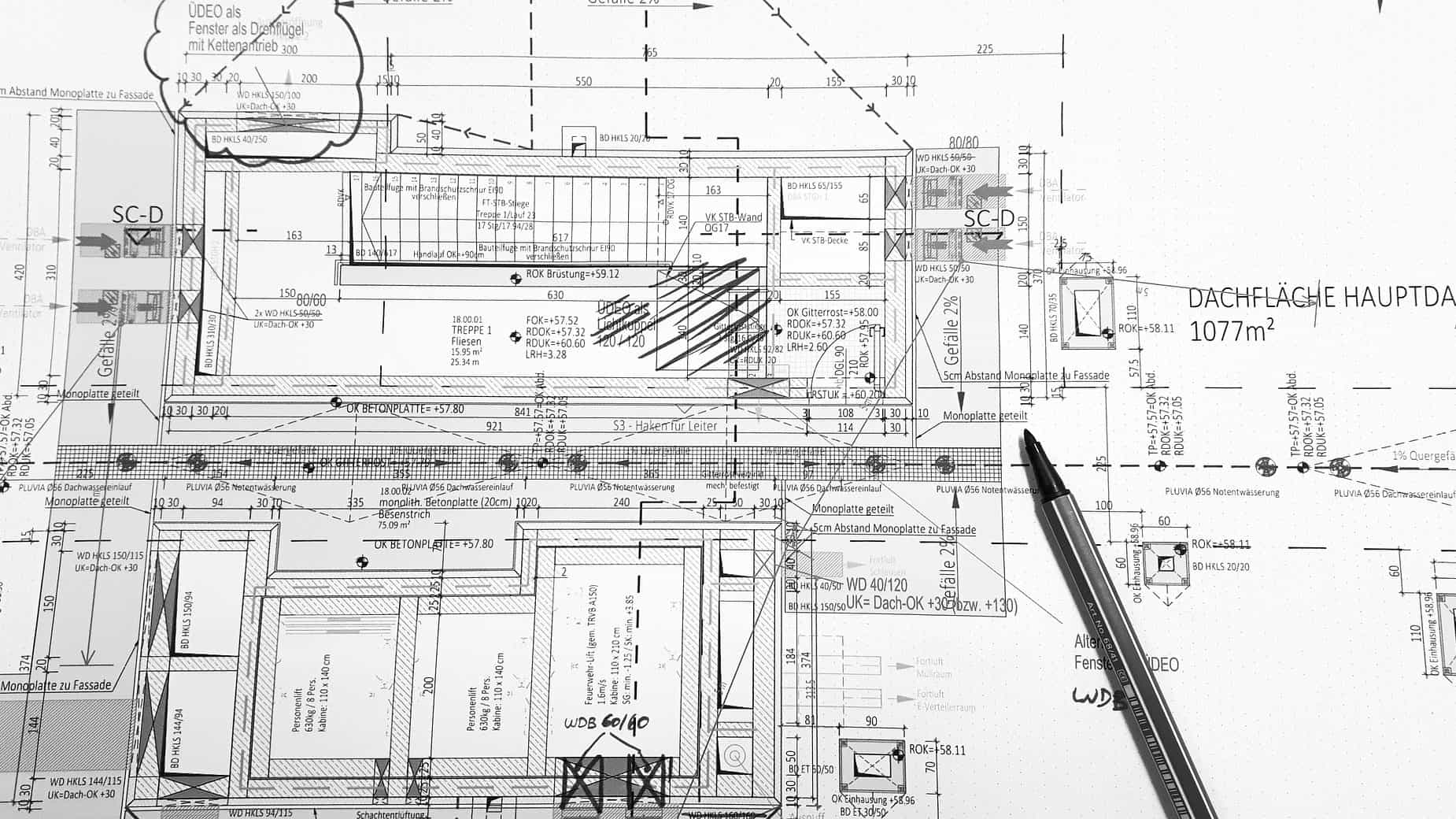
How To Issue An RFI
As I’ve noted above – an RFI (request for information) is really just a fancy way of issuing a question. Because of that, the central part of your RFI needs to be a question.
The process of issuing an RFI is typically outlined in the project specifications. I’ve included an example specification below which outlines the RFI Procedures (click on the pictures to increase the size):
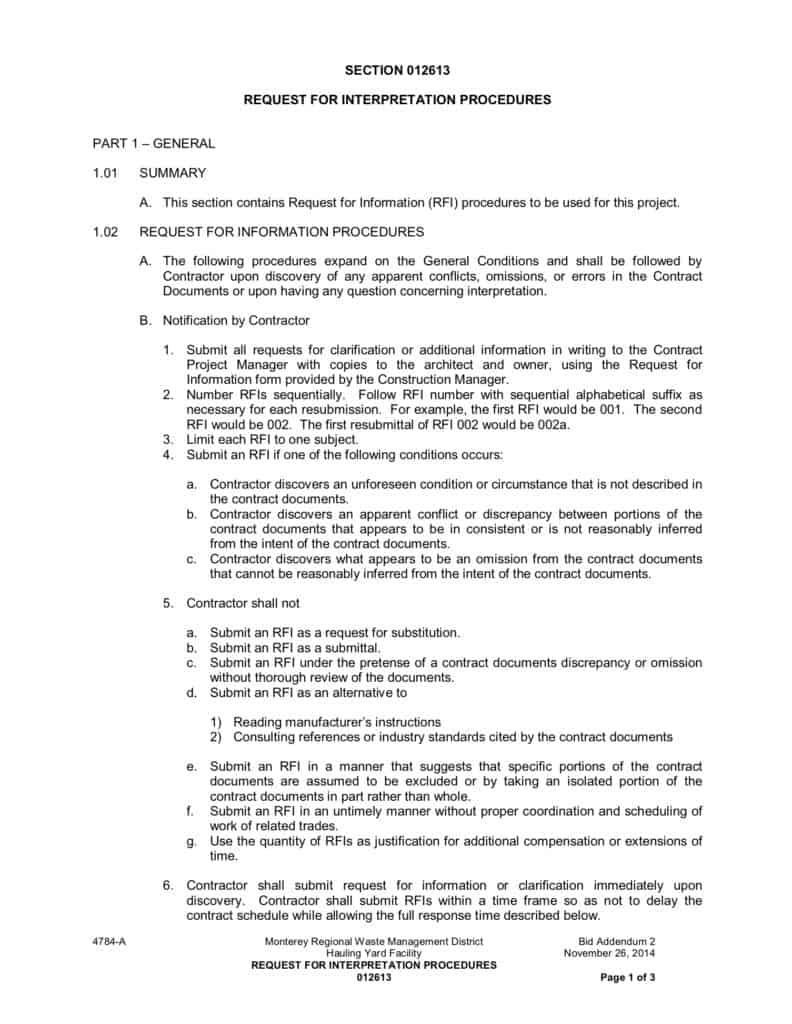
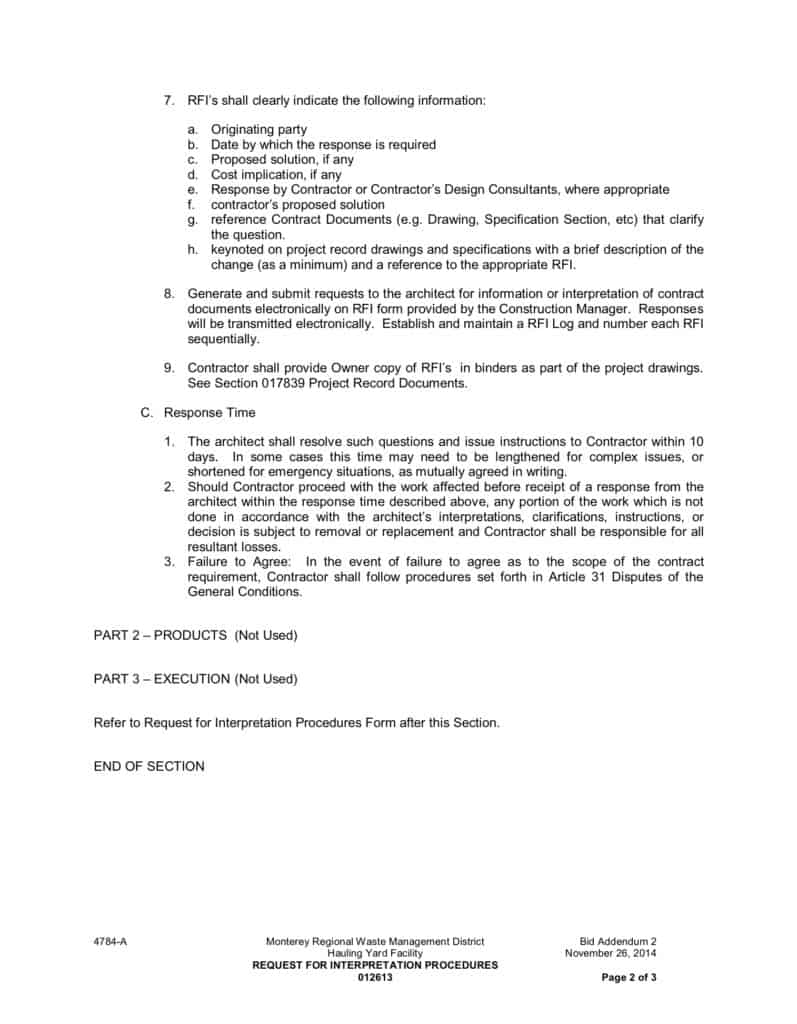
As you can see there are some very defined procedures. If they are not included in the specifications you will often find them within your contract.
Let’s break the above down a bit:
Notification by Contractor – in this section it asks you to submit all requests for information to the project manager and the consultant. In this case it’s asking you to utilize a specific form. In my personal experience there is some flexibility in this (we’ll talk about that in a second).
Contractor Shall Not – in this section it’s outlining items that you should not be using the RFI process for. I’d encourage you to avoid these situations and it drives consultants crazy when you submit an RFI for a project substitute!
RFI’s shall clearly indicate – this section identifies what exactly you need to include n the RFI and information you need to provide.
Response Time – this section defines how long the consultant has to respond to your question. On this particular project it is 10 days, which is in line with construction industry standards.
When issuing an RFI it’s clear that there are a number restrictions on both the way you do it and when to do it. So what is the best way to issue an RFI. I’m going to break it down into three categories – old school, new school, advanced.
The Old Way
Don’t just assume that because there is an old way of doing things it doesn’t work. Prior to computers and email there fax machines and letters were used to communicate on your construction project. Depending upon where your project is located this may still be the way of issuing RFIs to your project consultants.
A fundamental way of dealing with RFI’s that has been lost somewhat is an person meeting. My favourite way of dealing with issues is getting the consultant down on site and viewing it in person. By allowing people to view the issue for themselves it forces them to understand the nuances and complexities.
The New Way
The invention of the computer and access to the internet from our cellphones has made communication easier. With that it has also simplified the way RFI’s are issued. Most specifications that are issued now include a procedure for RFI’s to be issued via email.
When issuing an RFI – most projects require you to fill out a form. An RFI request form can either be outlined in the project documents, or if you don’t have one simply follow the link above.
Advanced Methods
There are a number of advanced techniques to issuing requests for information on your construction site. Many of them involve technology.
The most effective way to issue RFI’s is through a project management platform. Platforms such as Procore and Autodesk can automate the sending, reminders and provide a central place for people to issue and respond to questions.

Responding To An RFI
I often write articles on this site from the perspective of the general contractor. For this article we’re going to provide some advice to the consultants and engineers on how to respond to RFIs.
Let’s walk through the five steps to responding to an RFI:
Step One – Understand The Urgency Of The RFI
After you receive an RFI from the contractor – the first step is understanding how urgent the request is. Do this by either reviewing the document you’ve received from the contractor or asking the question. Typically there will be a due date on the actual RFI that the contractor requires a response by.
Step Two – Determine who’s responsible and distribute as required
Review the question and determine which of the sub consultants is required in order to respond to the question. Once you’ve determined who needs to be involved distribute the RFI to them and confirm what they are responsible for.
Step Three – Review the RFI And Research
Review the question in detail – if you don’t fully understand the question pick up the phone and call whoever issued the RFI. The best thing you can do when reviewing an RFI is to have a conversation about it with the person who issued it. What’s the reason they issued it, is it urgent, do they have a recommended solution, does your proposed solution impact anything else on site.
Step Four – Collect responses from the subconsultants
Since you issued the document earlier to various parties collect their responses. Review each of the responses and ensure that they are coordinated or if they require further information. Once you’re happy that they are on the same page consolidate each of the responses within the RFI.
Step Five – Respond To The RFI
Issue a formal response to the contractor on the original RFI form or in their project management system. Ensure that the RFI is reassigned to the contractor or whoever issued it.
As a special note – if the RFI impacts the contract documents you will need to issue a change notice or site instruction to the contractor.
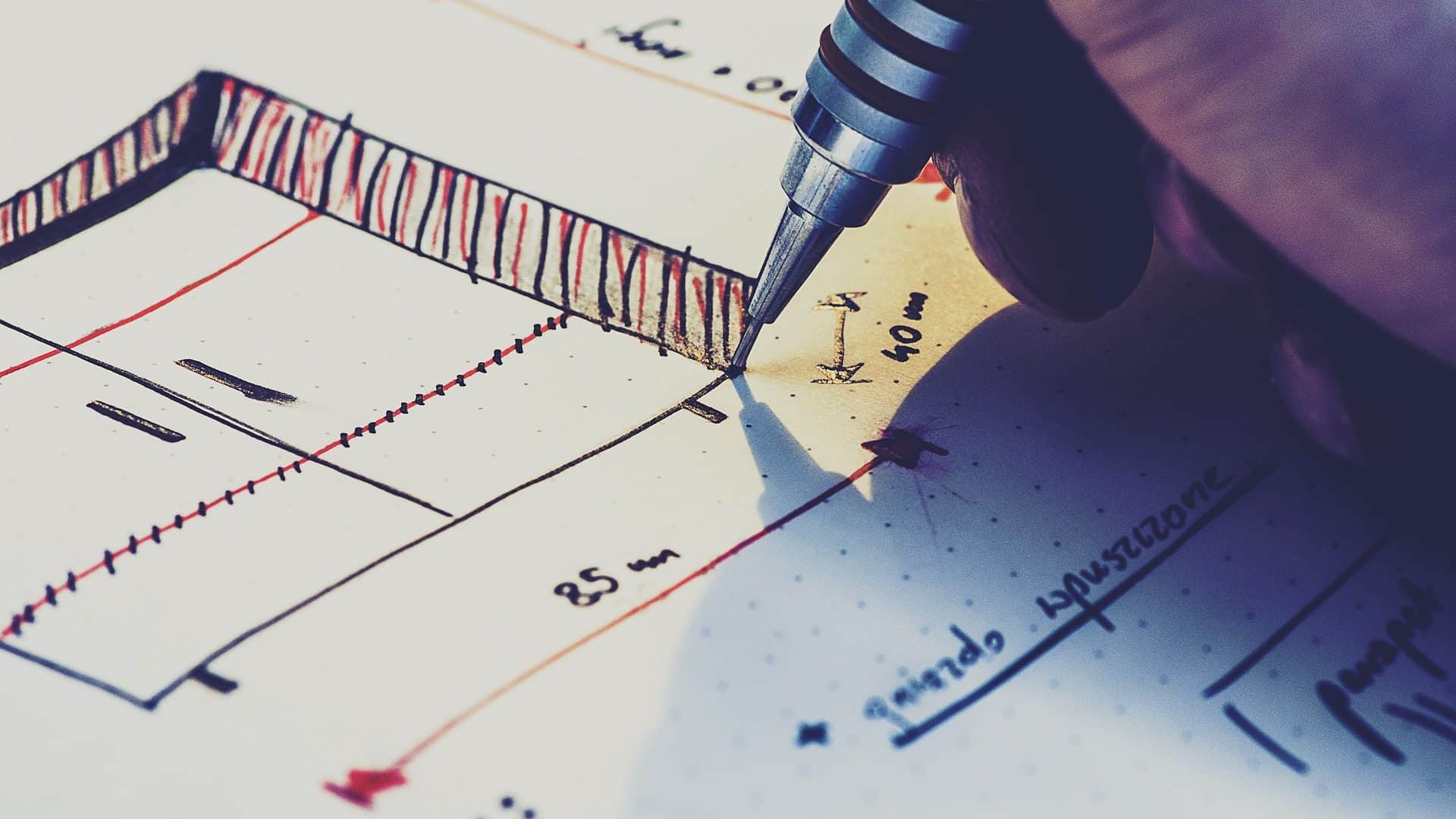
How to Track and Manage RFIs On Your Construction Site
According to the Construction Management Association the average project across global jobsites will have roughly 796 RFIs. That’s a staggering number and a massive amount of communication to keep track of. Further – if left unchecked a delay in RFI responses can have a negative impact on your project.
So how can you manage this process to ensure your project goes smoothly?
The first step to successfully managing RFIs on your project is by understanding the workflow. A workflow is a document which outlines the steps to be followed for an RFI. Below is chart which is a sample RFI document workflow:

What is the workflow on your project? Do you issue RFI’s directly to the architect, maybe the owner or the subconsultants? If you need an assist we’ve created an RFI workflow template for you.
After you’ve established the workflow and the questions start flowing from your project team the next step is tracking.
Effective Techniques for Tracking And Managing
There are a number of simple things you can do to track RFIs and manage them effectively, here they are:
- Number each RFI with a unique identifier. This can be something as simple as identifying each with a number starting from one.
- Log the date sent and date returned.
- Provide the discipline – this will allow you to categorize them for better tracking.
- Identify the ball in court
- Include key indicators – as an example floor, elevation, phase or area of a project
If you don’t have access to a construction management platform the easiest way to track the above information is by preparing a spreadsheet. A RFI tracking log will help you assign information against each RFI and understand the status of each one.

Statistics and Trends To Be Aware of
Given that the RFI is such a standard part of every project it’s important to understand the various statistics and trends on projects.
To start let’s run through some key statistics and how they impact your project:

The above chart indicates the average number of RFIs based on the length of the project. As you can see the duration is generally directly tied to the number of RFI’s with the number going up consistently depending upon the duration.
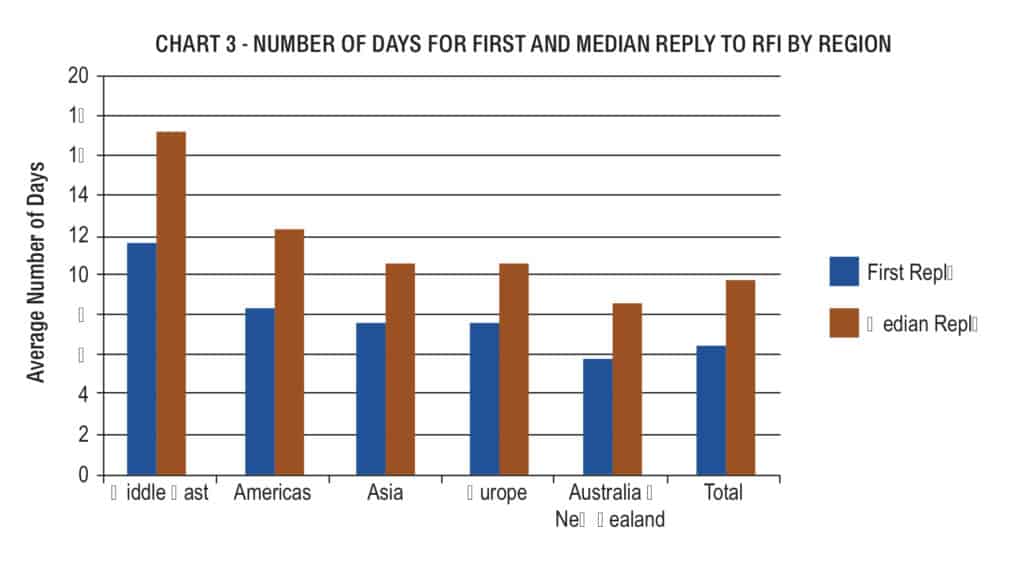
The above chart indicates the number of days for first and median (middle) reply to RFIs. This will help you in scheduling. Depending on where you work you can expect responses within 5-10 business days (Australians seem to be better!).
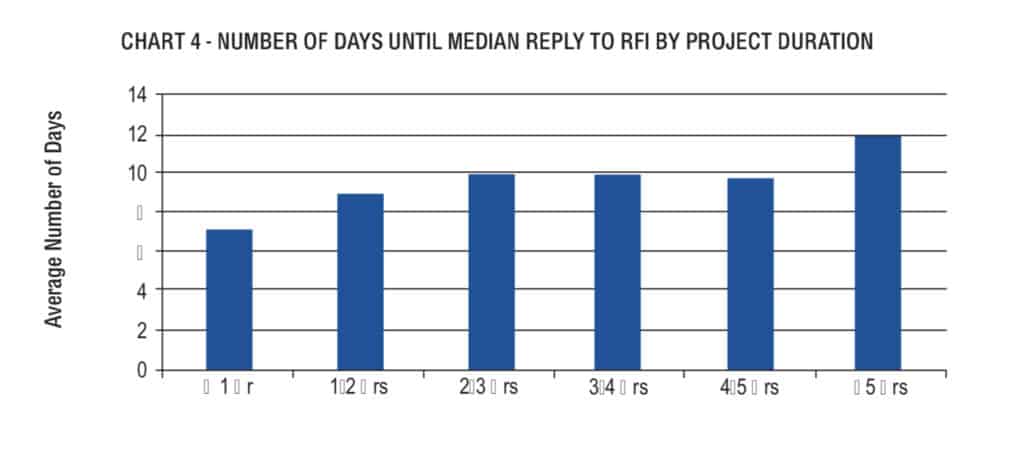
I thought this graph was funny – it appears that as the project get’s longer, the more fatigued people get with project administration and the longer RFI’s take to get responded to.
Trends in the Project Administration Universe
There are a few key trends that I wanted to identify to you – specifically when it comes to technology.
- Project Management platforms – I mentioned this one above but platforms such as Procore, Autodesk Bim360, and many apps you’ll find on your phone can help streamline the process. Where these platforms really shine however is that everyone is on the platform. Your architect responds directly on the website which saves you time in compiling and ensuring the latest information is in front of those in the field.
- Building Information Modelling – coordinating a building before it’s built has never been easier with BIM and modelling. This allows you to identify issues prior to them being built. This is especially useful in clash detection.
- Drawing Review Software – with machine learning becoming more common on the construction site software such as Pype is working to identify deficiencies in the design.
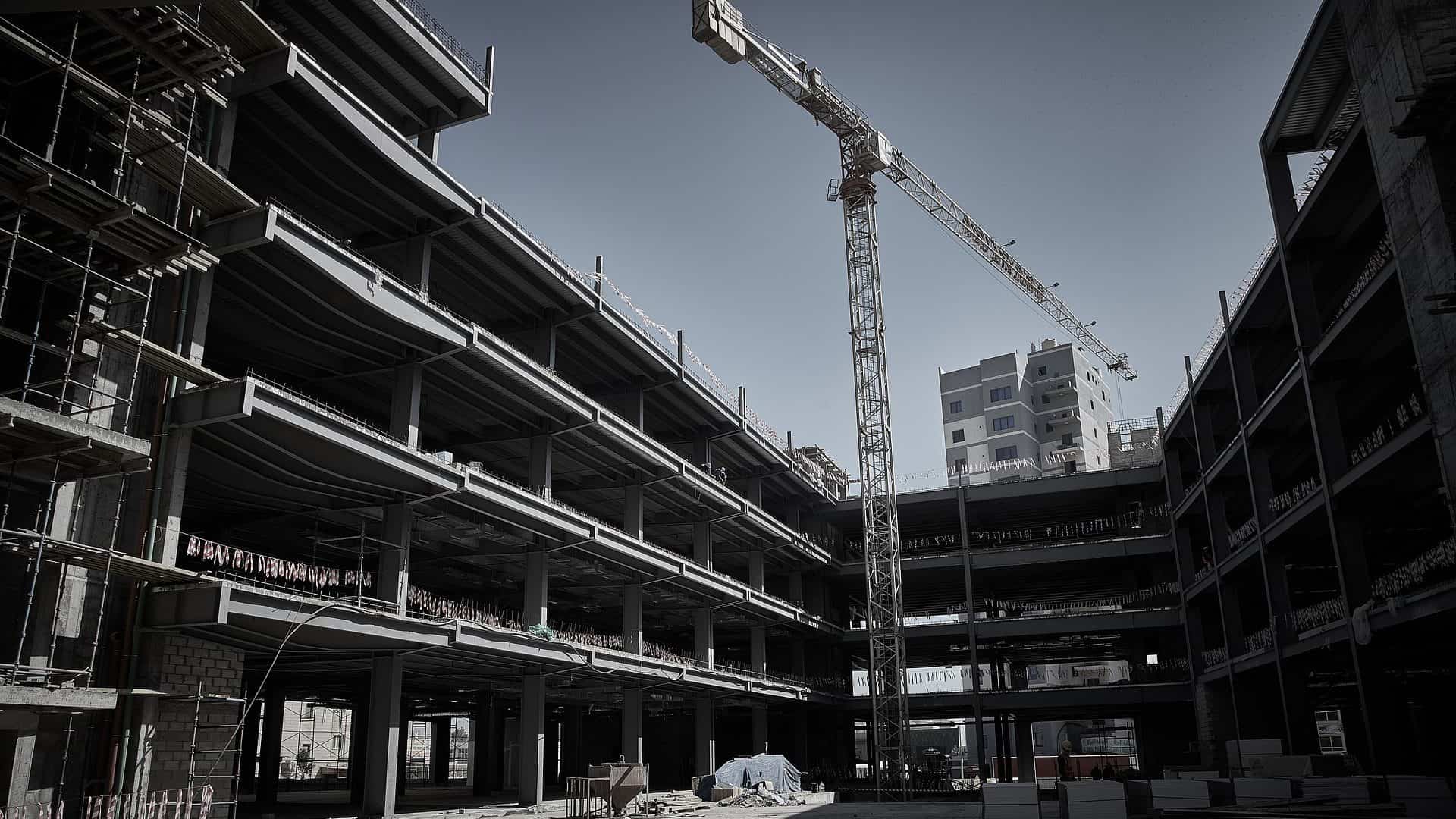
Best Practices For Issuing An RFI On A Construction Project
In this last section I’m going to identify three best practices for issuing RFI’s on the construction project.
Make A Recommendation
For each RFI issued it should also come with a recommended solution. You as the contractor have an opinion, and a preferred solution. Make your consultants life easier by including that in your RFI. They can choose to use it or ignore it but by making a suggestion you’ll be seen as a solution provider.
Track Across Projects and Review Historical Data
Projects that are similar to one another will have similar issues. Share your RFI logs across the company – identify where problems exist on each of the projects. Before closing a project review the RFI logs from past projects – identify where major issues occurred and make allowances for them.
Distribute RFI Logs Once A Week
RFI logs are the central source for where each of your RFIs is and who’s court its in. People are busy and aren’t always sure where to focus their time. By distributing your RFI log weekly you’re giving people a reminder to work on these items by keeping it front and center.
Wrapping Up
The RFI is a fundamental part of any construction project. How do you issue your RFIs? How are they tracked? Is there a key person responsible for them or does each member issue them?
Let us know how you deal with RFI’s on your construction project below in the comments.

Thanks for sharing this information, If anyone looking for Construction services in Dallas, contact Monoxy Commercial ConstructionMonoxy Commercial Construction, where you can get commercial contractor services in Dallas.
very good quality industrial fans, vantilation and exhaust fan’s
Very Informative info about RFI’s thanks!